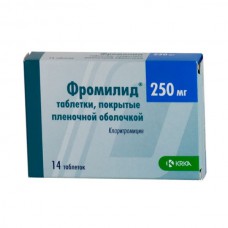Expiration date: 05/2026
Composition and form of issue:
Tablets, film-coated. 1 tablet contains:
clarithromycin 250 or 500 mg
excipients: corn starch MCC (Avicel PH 101) microcrystalline (Avicel PH 102) silica colloidal anhydrous starch pregelatinization polacrilin potassium, talc magnesium stearate
shell: gipromelloza 6 cps talc dye quinoline yellow (E104) propylene glycol titanium dioxide (E171)
the blisters 7 PC. in the paper cartons 2 blister.
Granules for suspension preparation for oral administration. 1 flask (25 g of granules) contains:
clarithromycin 1, 5 g
excipients: carbomer 934p povidone hypromellose phthalate (HP 55) talc castor oil gum xanthan flavor banana citric acid anhydrous potassium sorbate silicon dioxide colloidal anhydrous titanium dioxide sucrose
in bottles of dark glass 100 ml (with dosing syringe) in a pack of cardboard 1 bottle.
Description of dosage form:
Tablets 250 and 500 mg: oval, biconvex, film-coated light yellow.
View of the fracture: a mass of white with a layer of slightly yellowish shell.
Granules for the preparation of suspensions for oral administration: small, from white to light yellow, with the smell of banana.
Appearance of the suspension: homogeneous aqueous suspension of yellowish-white color, with the smell of banana.
Pharmacokinetics:
Clarithromycin is well absorbed from the gastrointestinal tract. Bioavailability-55%, when taken orally. Food slows absorption, but it does not significantly affect the bioavailability of clarithromycin. Protein binding is more than 90%. Approximately 20% of clarithromycin is immediately metabolized in the liver by cytochrome CYP3A4, CYP3A5 and CYP3A7 enzymes into the main metabolite — 14-hydroxyclarithromycin, which has a pronounced activity against Haemophilus influenzae. Tmax is less than 3 hours. With regular intake of 250 mg / day, the equilibrium concentration (CSS) of the unchanged drug-0, 62-0, 84 mg / ml and its main metabolite-0, 4-0, 7 mg / ml, respectively, with an increase in the dose to 500 mg / day CSS of the unchanged drug 1, 77-1, 89 mg / ml and its metabolite in plasma-0, 67-0, 8 mg/ml. Clarithromycin easily penetrates the tissues and fluids of the body (lungs, middle ear, skin and soft tissues of the body), where it reaches a concentration of almost 10 times the concentration in serum. T1/2 after oral dose of 250 mg is 3 to 4 hours after administration of doses 500 mg — 5 to 7 hours From 20 to 30% of clarithromycin (40% when receiving a suspension) place in an unmodified form by the kidneys, the remainder is excreted as metabolites.
Description of the pharmacological action:
Clarithromycin is a semi-synthetic antibiotic from the macrolide group.
It inhibits protein synthesis in microbial cell, mainly has bacteriostatic effect in high concentrations has bactericidal effect on Streptococcus pyogenes, Streptococcus pneumoniae and Moraxella catarrhalis. Clarithromycin-sensitive microorganisms: Mycoplasma pneumoniae, Legionella pneumophila, Chlamydia trachomatis and Chlamydia pneumoniae, Ureaplasma urealyticum gram-positive microorganisms (Streptococcus pyogenes, Streptococcus pneumoniae, Streptococcus agalactiae, Streptococcus viridans, Streptococcus Staphylococcus aureus, Listeria monocytogenes, Corynebacterium spp., Bacillus spp.) gram-negative microorganisms (Haemophilus influenzae and Haemophilus ducreyi, Moraxella catarrhalis, Bordetella pertussis, Neisseria gonorrhoeae and Neisseria meningitidis, Borrelia burgdorferi, Pasteurella multocida, Campylobacter spp. and Helicobacter pylori) some anaerobes (Eubacterium spp., Peptococcus spp., Propionibacterium spp., Clostridium perfringens and Bacteroides melaninogenicus) Toxoplasma gondii and all mycobacteria except Mycobacterium tuberculosis.
Indications:
Infectious and inflammatory diseases caused by microorganisms sensitive to the drug:
- upper respiratory tract infections (acute and chronic tonsillopharyngitis, acute and chronic recurrent sinusitis, acute otitis media)
- infections of the lower respiratory tract (acute bacterial bronchitis, exacerbation of chronic bronchitis, community-acquired bacterial pneumonia, including pneumonia caused by atypical pathogens)
- skin and soft tissue infections
- infections caused by Mycobacterium (Mycobacterium avium complex, Mycobacterium kansasii, Mycobacterium marinum, Mycobacterium leprae)
- prevention of the spread of infections caused by Mycobacterium avium complex (MAC) in HIV-infected patients with CD4 lymphocyte (T-helper lymphocyte) no more than 100 in 1 mm3
- eradication Helicobacter pylori in patients with duodenal ulcer or stomach (always in combination with other drugs).
Contraindications:
- hypersensitivity to clarithromycin or other antibacterial drugs in the macrolide group or other components of the drug
- hepatic insufficiency of severe degree
- hepatitis (in the anamnesis)
- porphyria
- The first trimester of pregnancy
- lactation
- concomitant therapy with terfenadine, cisapride, pimozide or astemizole
- children under 6 months of age (for dosage form — granules for preparation of suspension for oral administration) - there is not enough experience with the effectiveness and safety of the use
- children under 12 years of age and / or weighing less than 33 kg (for dosage form — film-coated tablets)
- congenital fructose intolerance, glucose/galactose malabsorption syndrome or isomaltase-sucrase enzyme deficiency (only for dosage form — granules for oral suspension).
Caution: II-III trimesters of pregnancy, moderate and severe renal insufficiency, hepatic insufficiency.
Application for pregnancy and breastfeeding:
Clarithromycin can be used in the II and III trimesters of pregnancy only in cases where the expected benefit to the mother exceeds the potential risk to the fetus.
If necessary, use of the drug during lactation should stop breastfeeding.
Side effect:
From the digestive system: nausea, vomiting, diarrhea, abdominal pain, stomatitis, glossitis, short-term discoloration of teeth and tongue, pancreatitis, pseudomembranous enterocolitis, cholestatic jaundice, hepatitis. Liver disorders can be severe, but usually reversible. Very rarely have cases of liver failure and death occurred, mainly due to severe comorbidities and/or concomitant drug therapy.
From the Central and peripheral nervous system: headache, vertigo, paresthesia, drowsiness, hallucinations, convulsions, psychosis, dizziness, confusion, fear, insomnia, nightmares, depersonalization, disorientation.
From the hematopoietic and lymphatic system: leukopenia, thrombocytopenia.
On the part of the senses: change in taste (dysgeusia), smell ringing in the ears, short-term hearing loss, taking place after the abolition of the drug.
On the part of the cardiovascular system: QT prolongation on ECG, ventricular tachycardia type "pirouette" ("torsades de pointes").
Respiratory system: shortness of breath.
From the musculoskeletal system: arthralgia, myalgia.
From the genitourinary system: interstitial nephritis, renal failure.
Allergic reactions: skin rash, urticaria, itching, swelling of the face, anaphylactic shock, Stevens-Johnson syndrome, toxic epidermal necrolysis (Lyell's syndrome), angioedema quince.
Laboratory indicators: increased activity of hepatic transaminases and SCF, increased serum levels of bilirubin, creatinine, uric acid, elongation of PV, thrombocytopenia (unusual bleeding, hemorrhaging), leukopenia, neutropenia, hypoglycemia in patients receiving hypoglycemic drugs.
Other: long-term use may develop cases of superinfection, candidiasis, resistance of microorganisms (pseudomembranous colitis, candidiasis of the oral cavity).
Drug interaction:
Clarithromycin is metabolized in the liver, where it can inhibit the action of cytochrome P450 enzymes. With simultaneous treatment with clarithromycin and other drugs metabolized through this system, the concentration of the latter may increase and cause side effects. Therefore, terfenadine, cisapride, pimozide or astemizole should not be prescribed during treatment with clarithromycin due to the threat of life-threatening arrhythmias. It is recommended to measure the concentrations of theophylline, carbamazepine, digoxin, lovastatin, simvastatin, triazolam, midazolam, phenytoin, cyclosporine, dizopiramida, rifabutin, tacrolimus, Itraconazole and Argyle alkaloids in serum, when they are prescribed simultaneously with clarithromycin, as increases the risk of side effects of the latter.
It should be periodically monitored in patients receiving clarithromycin simultaneously with warfarin or other oral anticoagulants.
Simultaneous administration of clarithromycin and zidovudine reduces the absorption of zidovudine (an interval of at least 4 hours is required between the use of drugs).
Coadministration of ritonavir and clarithromycin leads to a significant increase in the levels of clarithromycin in serum and a significant reduction in the levels of its metabolite 14-hydroxyclarithromycin in the serum.
The development of cross-resistance between clarithromycin, lincomycin and clindamycin is possible.
Method of application and doses:
Inside, swallowing whole, without breaking, squeezed small amount of liquid.
Adults and children over 12 years of age and/or body weight &ge33 kg is usually prescribed 250 mg every 12 h For the treatment of acute sinusitis, severe infections and, when infection is caused by Haemophilus influenzae prescribed 500 mg of clarithromycin every 12 hours the Course of treatment 7-14 days.
For the purpose of H. pylori eradication clarithromycin is prescribed at a dose of 250-500 mg 2 times a day, usually within 7 days, in combination with other drugs. Children under the age of 12 years and/or weighing less than 33 kg are usually prescribed a suspension at a dose of 15 mg/kg/day, divided into 2 admission. It is recommended to give a little liquid after taking the suspension. The suspension contains tiny granules, which should not be chewed, because their content has a bitter taste. Attached syringe for oral administration of the drug. One filled syringe contains 5 ml of suspension containing 125 mg of clarithromycin. After each use, rinse the syringe. The dose of the drug in Pediatrics is calculated by body weight of the child.
The course of treatment usually lasts for 7-14 days.
For the treatment and prevention of infection caused by the bacterium Mycobacterium avium complex, should appoint 500 mg every 12 hours Dose can be increased. The maximum daily dose is 2 g. Children are prescribed a dose of clarithromycin, divided into two doses, at the rate — 15 mg/kg/day.
The dose should not exceed 500 mg every 12 hours the Maximum daily dose recommended for children is 1 g.
Treatment of infection caused by Mycobacterium avium complex, prolonged, 6 months or more.
In the case of renal insufficiency, if the creatinine Cl is less than 30 ml/min, or serum creatinine is more than 290 mmol/l (3, 3 mg / 100 ml), the dose should be reduced by 2 times or double the interval between doses. The maximum duration of treatment in patients of this group — 14 days.
Preparation of the suspension
42 ml of water is required to prepare the suspension.
Pre-shake the bottle to the granules in it crumbled. Add 1/4 volume of water in a bottle and shake well to dissolve the granules. Add the rest of the water and shake well. The volume of the finished suspension should reach the mark line on the vial.
Overdose:
Symptoms: vomiting, abdominal pain, headache and confusion.
Treatment: gastric lavage, symptomatic therapy.
Special instruction:
Cross-resistance exists among macrolide antibiotics.
Dose adjustment is not necessary for patients with impaired hepatic function of average degree, if the renal function is normal.
However, the dose should be reduced for patients with impaired renal function severe. In the presence of chronic liver disease, it is necessary to conduct regular monitoring of blood serum enzymes.
At simultaneous appointment of the medicines metabolized by a liver, it is recommended to measure their concentration in blood serum.
In case of co-administration with warfarin or other indirect anticoagulants it is necessary to control the PV.
Currently, there is not enough experience on the effectiveness and safety of clarithromycin in the treatment of children under 6 months.
Antibiotic treatment changes the normal flora of the intestine, so there may be superinfection caused by resistant microorganisms. In the case of severe, persistent diarrhea, which may indicate pseudomembranous colitis, discontinue use of the drug and consult a doctor.
125 mg granules for oral suspension for oral administration, the concentration of 125 mg/5 ml, contains 1, 6 g of sucrose, therefore the drug is not recommended for children with congenital intolerance to fructose, syndrome of malabsorption of glucose/galactose or deficiency of the enzyme sucrase-isomaltase.
Influence on ability to driving and other mechanical devices. The drug has no effect on the speed of psychomotor reactions of the patient when driving or working with machinery.



